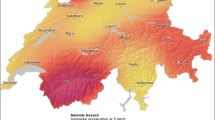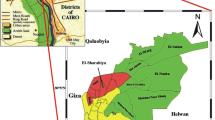Abstract
The impact of earthquakes in urban centers prone to disastrous earthquakes necessitates the analysis of associated risk for rational formulation of contingency plans and mitigation strategies. In urban centers, the seismic risk is best quantified and portrayed through the preparation of “Earthquake Damage and Loss Scenarios.” The components of such scenarios are the assessment of the hazard, inventories and the vulnerabilities of elements at risk. For the development of the earthquake risk scenario in Istanbul, two independent approaches, one based on intensities and the second on spectral displacements, are utilized. This paper will present the important features of a comprehensive study, highlight the methodology, discuss the results and provide insights to future developments.
Similar content being viewed by others
References
Ambraseys NN and Finkel CF (1991), “Longterm Seismicity of Istanbul and of the Marmara Sea Region,”Terra Nova, 3: 527–539.
Ambraseys NN and Jackson JA (1981), “Earthquake Hazard and Vulnerability in the Northeastern Mediterranean; the Corinth Earthquake Sequence of February-March 1981,”Disasters,5 (4): 355–368.
ATC 55 (2001), “Project to Evaluate and Improve Inelastic Seismic Analysis Procedures, for FEMA 2001 —present,” Applied Technology Council, Redwood City, California.
ATC —40 (1996), “Seismic Evaluation and Retrofit of Concrete Buildings,”Report ATC —40, Applied TechnologyCouncil, Redwood City, California.
Armijo R, Meyer B, Hubert A and Barka AA (1999), “Westward Propagation of the North Anatolian Fault into the Northern Aegean Timing and Kinematics,”Geology, 27: 267–270.
Aydinoglu N and Kacmaz U (2002), “Displacement Modification Factor for Seismic Inelastic Evaluation,” submitted for publication in Earthquake Engineering and Structural Dynamics.
Barbat AH, Moya FY and Canas JA (1996), “Damage Scenarios Simulation for Seismic Risk Assessment in Urban Zone,”Earthquake Spectra,12 (3): 371–394.
Boore DM., Joyner WB, Fumai TE (1997), “Equations for Estimating Horizontal Response Spectra and Peak Acceleration from Western North American Earthquakes: A Summary of Recent Work,”Seismological Research Letters,68 (1) : 128–153.
Chopra AK and Goel RK (1999), “Capacity-Demand-Diagram Methods Based on Inelastic Design Spectrum,”Earthquake Spectra,15 (4): 637–656.
Coburn A and Spence R (1992),Earthquake Protection; John Wiley and Sons Ltd., Chichester, 355.
Department of Earthquake Engineering (2002), “Earthquake Risk Assessment For Istanbul Metropolitan Area,”Report prepared for American Red Cross and Turkish Red Crescent, Bogazici University, Istanbul, Turkey.
Durukal E, Erdik M (1994), “Strong Motion Instrumentation of Aya Sofya and the Analysis of Earthquake Response,”Proceedings of the Fifth US. National Conference on Earthquake Engineering, July 10–14 1994, Chicago, pp. 343–352.
Eguchi RT, Goltz JD, Seligson HA, Flores PJ, Heaton TH and Bortugno E (1997), “Real-time Loss Estimation as an Emergency Response Descision Support System; The Early Post-Earthquake Damage Assessment Tool (EPEDAT),”Earthquake Spectra, 13: 815–832.
ENSeRVES (2000), “European Network on Seismic Risk, Vulnerability and Earthquake Scenarios,”Proc. International Workshop on Seismic Risk and Earthquake Scenarios of Potenza, University of Basilicata.
Erdik M, Avc? J, Durukal E (1995), “Developing an Earthquake Damage Scenario for Istanbul,”Proceedings of the Fifth International Conference on Seismic Zonation, 17–19 October 1995, Nice: 1297–1304.
Erdik M. (2001),Report on 1999Kocaeli and Duzce (Turkey) Earthquakes, in Structural Control for Civil and Infrastructure Engineering, Ed. by, F. Casciati, G. Magonette, World Scientific.
Erdik M., Ansal A, Aydinoglu N, Barka A, Yuzugullu O, Birgoren G, Swift J, Alpay Y, Sesetyan K (2000), “Development of Earthquake Masterplan for the Municipality of Izmir,”Proc., Sixth International Conference on Seismic Zonation, Palm Springs, November 12–15, 2000, EERI, San Francisco.
Erdik M, Doyuran V, Akkas P and Gulkan P (1985),“Assessment of the Earthquake Hazard in Turkey and Neighboring Regions,”Tectonophysics,117: 295–344.
Erdik M, Yuzugullu O, Yilmaz C and Akkas N (1992), “March 13, 1992 (Ms = 6.8) Erzincan Earthquake ; A Preliminary Reconnaissance Report,”Soil Dynamics and Earthquake Engineering, volume 11 (5): 279–310.
Evernden JF and Thomson JM (1985), “Predicting Seismic Intensities,”U. S. Geological Survey Profes. Paper 1360: 151–202.
Faccioli E (Coordinatore)et al. (1997), “Scenari di danno da terremoto per il comune di Catania,” Gruppe Nazionale per la Difesa dei Terremoti, Italy.
Faeh D, Kind F, Lang K and Giardini D (2001), “Earthquake Scenarios for the City of Basel,”Soil Dynamics and Earthquake Engineering, 21: 405–413.
FEMA 273 (1997), “Federal Emergency Management Agency, NEHRP Guidelines for the Seismic Rehabilitation of Buildings,”FEMA Publication 273, Washington DC.
FEMA 356 (2000), “Federal Emergency Management Agency, Prestandard and Commentary for the Seismic Rehabilitation of Buildings,”FEMA Publication 356, Washington DC.
Fernandez J, Valverde J, Yepes H, Tucker B, Bustamante G, Chatelain JL, Kaneko F, Villacis C, Yamada T (1994), “The Quito, Equador, Earthquake Risk Management Project, an Overview” Published by Geohazards International, pp. 34.
Gruenthal G (1998), “European Macroseismic Scale 1998. Cahiers du Centre Europ en de G odynamique et de Séismologie,” 15, Luxembourg, pp.99.
HAZUS (1999), “Earthquake Loss Estimation Methodology,Technical Manual, RMS, NIBS and FE-MA.”
IDNDR-Radius, http://www. reliefweb. int/ocha ol/programs/idndr/radius. html.
Joyner WB and DM Boore (1988), “Measurement, Characterization, and Prediction of Strong Ground Motion,”Proceedings of Earthquake Engineering and Soil Dynamics II, GT DIV/ASCE, Park City Utah, June 27–30, 1988, pp.43-102.
Komaru Y, Yamada T, Segawa S and Villacis C (1995), “Development of an Earthquake Damage Estimation System,”Proc. of the 10thECEE, Vienna, 1994.
Leyendecker EV, Hunt RJ, Frankel AD and Rukstales KS (2000),“Development of Maximum Considered Earthquake Ground Motion Maps,”Earthquake Spectra, Earthquake Engineering Research Institute, Oakland.
Mapinfo Professional® Software, http://www. mapinfo. com.
NEHRP (1997), “Recommended Provisions For Seismic Regulations For New Buildings and Other Structures, FEMA-303,” Prepared by the Building Seismic Safety Council for the Federal Emergency Management Agency, Washington, DC.
Ohta Y (1983), “A Comprehensive Study on Earthquake Disaster in Turkey,” Hokkaido University, Japan.
Ozbey C (2001), “Empirical Peak Horizontal Acceleration Attenuation Relationship for Northwestern Turkey,”M. Sc. Thesis, KOERI, Bogazici University.
Parsons T, Toda S, Stein RS, Barka A and Dieterich JH (2000), “Heightened Odds of Large Earthquakes Near Istanbul; An Interaction-based Probability Calculation,”Science, 288: 661–665.
Sadigh K, Chang CY, Egan JA, Makdisi F, Youngs RR (1997), “Attenuation Relationships for Shallow Crustal Earthquakes Based on California Strong Motion Data,”Seismological Research Letters,68: 180–189.
Somerville PG, Smith NF, Graves RW and Abrahamson NA (1997),“Modification of Empirical Strong Ground Motion Attenuation Relations to Include the Amplitude and Duration Effects of Rupture Directivity,”Seismological Research Letters,68: 199–222.
Tucker B and Erdik M (1994),Issues in Urban Earthquake Risk, Kluwer Academic Publishers, 1994.
Wenzel F, Lungu D. and Novak O. (1998), “Vrancea Earthquakes: Tectonics, Hazard and Risk Mitigation,”selected papers of the First International Workshop on Vrancea Earthquakes, Bucharest, November 1–4, 1997, Kluwer Academic Publishers, Dordrecht, Netherlands, pp. 374.
Whitman RV and Lagorio HJ (1999), “The FEMANIBS Methodology For Earthquake Loss Estimation,” (http ://www. fema. gov/hazus/hazus4a. htm).
WGCEP90 (1990), “Probabilities of large earthquakes in the san Francisco Bay region,” California, U.S. geol. Surv. Circ, pp.1053.
Youd L and Perkins DM (1978), “Mapping of Liquefaction Induced Ground Failure Potential,”J. GED, ASCE,104 (4): 433–446.
Author information
Authors and Affiliations
Corresponding author
Rights and permissions
About this article
Cite this article
Erdik, M., Aydinoglu, N., Fahjan, Y. et al. Earthquake risk assessment for Istanbul metropolitan area. Earthq. Eng. Eng. Vib. 2, 1–23 (2003). https://doi.org/10.1007/BF02857534
Received:
Accepted:
Issue Date:
DOI: https://doi.org/10.1007/BF02857534




